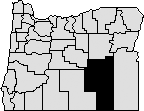
Harney County was created from the southern two-thirds of Grant County on Feb.
25, 1889. It is located in the high desert country in the southeast
of the state and is the largest county in Oregon, comprising 10,228 square miles. Border counties
include Malheur to the east; Lake, Deschutes, and Crook to the west; Grant to the north; and the State of Nevada to the south. The county was named after the lake in its territory, which was named in honor of General William S. Harney, commander of the Department of Oregon of the U.S. Army in 1858-1859.
The county's principal city and administrative seat, Burns, was officially established in 1884 and incorporated upon the county's creation in 1889. It was named for the Scottish poet Robert Burns by an early settler and County Commissioner George McGowan. The original county courthouse was built
in 1890 as the Smith and Young building. The building was purchased by citizens of Burns and donated to the county as an inducement to voters during the struggle that took place between Burns and Harney over the designation of the county seat. The current courthouse was built
in 1942.
Established by state legislation, elected officials have included a judge, county commissioners, clerk, auditor, recorder, sheriff, treasurer, assessor, surveyor, coroner, and school superintendent.
Three industries, cattle raising, sheep raising
and timber, have traditionally provided the county's economic base. The railroad, which came
to the area in 1883, served as a catalyst to the cattle industry but later contributed to its decline by bringing farmers and sheep men
creating increased competition for land. Harvesting and breeding of wild horses was lucrative for a period. Tourism based on sports and recreation is on the rise.
Harney County's population is concentrated in a small urbanized sector of Burns-Hines with the remainder mostly in the Harney Basin. The county's population was recorded as 2,559 during the 1890 census and rose steadily until
1930-40, and then resumed an upward curve until the 1980s. The county experienced a net out migration of nearly 15%
in the 1980s primarily due to the closure of the lumber mill in Burns. The 2011 population of 7,375 represented a 0.6% decrease over 2010.
Although Harney County lands were open to homesteading from 1862 to 1934, the federal Bureau of Land Management still owns more than 3 million acres. Facilitated on the national level by the Carey Act of 1894, arid land in Harney County was donated to the state for irrigation and settlement, but
water development efforts failed. Eventually, land claims under the reclamation legislation were abandoned or nullified. The Malheur National Wildlife Refuge was established in 1908 and expanded in the 1930s and 1940s. The refuge now includes 187,000 acres.
In addition to Malheur and Harney Lakes, other geographic landmarks of the county include the nearly 10,000-ft high Steens Mountain, known for its lava formations. Borax has been mined in the Steens area, and uranium has been found on its south side.